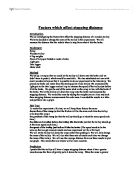Test 1
In my first test I will be testing ball 1 of radius 2 cm and mass of 2.8g, against ball 2 of radius 2 cm and mass of 44.9g. I will be dropping the ball from 30cm up the ramp with gradient of 24.4°, my results are:
Analysis
My first test supports my prediction that the mass of a ball does affect the distance that it takes to stop, although ball 2 is over 16 times heavier so I would have expected the stopping distance to be shorter.
Test 2
Again I will use ball 1 and ball 2 but this time I will drop them from a height of 40cm up the ramp with gradient 24.4°, my results are:
Analysis
As I expected when the dropping height was increased the relationship is the same just the distances are longer, I soon realised a fatly floor in my experiment the 2 balls were made out of 2 different materials so the coefficient of friction between the 2 balls and the surface would be different for each ball making my investigation unfair and inaccurate.
I decided to use a toy car and change the mass of the car by adding weights to it, this will mean that the coefficient of friction will be the same for all my tests.
New equipment
- toy car
- weights
- blue tac (to attach weights to car)
Test 3
Here I will be using the toy car of mass 17.4g, and I will add 17.4g so the cars mass will have doubled and I will further use the car plus 100g to see how this affects the stopping distance, my results are:
Analysis
From these results it is clear that my prediction is only partially correct as the mass of an object does affect its stopping distance but the relationship is not as linearly as I expected, as the mass is doubled the stopping distance is not halved this is due to the momentum that the object gains, when more mass is added the object gains more momentum proven with the momentum formulae momentum = mass * velocity, so the object will travel feather with more mass, this will explain why when the mass of my car had an extra 100g it travelled a further 77.2 cm. although its not that simple because we have to take into account friction, as the mass increases the gravitational pull of the earth will increase which in turn increases the amount of friction between the car wheels and the surface they roll on and a greater friction will slow down the car and reduce its stopping distance, this will explain why when I added only 17.4g the stopping distance was less . In theory there should be a certain mass that when added to an object the stopping distance will not change as the amount of extra momentum it gains will be cancelled out with the increased friction. I will extend my investigation to try and work out this quantity of mass.
Test 4
Here I will again be using a toy car and I will change the mass using weights from 20g up to 90g, dropping the car from a height of 10cm and gradient 24.4°.
Analysis
Analysing my results soon after the test I noticed a pattern within my results, although at mass 80g this was not true I decided to repeat the 80g run and found that the distance was actual higher and fit in with my other results.
Plotting a graph of my results shows the trend more clearly.
As you can see from 20g - 40g the stopping distance of the car decreases this is where the extra mass produces more friction than momentum, after this from 40g - 90g the stopping distance increases where the momentum is now greater than the friction, due to time restrictions I will only be able to make an estimate of the extra mass needed for friction and momentum to balance I will base my estimate on the results collected and my graph, the turning point is in between 40g and 50g so I will extrapolate from these to points in order to make my estimate.
Conclusion
In my experiment I aimed to find out whether or not the mass of a ball affects its stopping distance and if so how does it. I started out thinking I knew what was going to happened and that friction was the only point to consider, after my second test I knew something wasn’t right and decided to use the toy car, using the toy car was a massive benefit as I could change the mass so much easier and all other variables where kept the same (e.g. coefficient of friction). It was my first set of results with the toy car when I realised I had to take into account momentum this then explained everything about my previous results and everything fell into place. Feathering my investigation out of pure interest I decided to work out the balancing mass of friction and momentum but due to time restrictions I am only able to make an estimate of 42g due to extrapolating my graph. I enjoyed my physics investigation and wish I had more time to further it more.







